INTRODUCTION
Mistakes and Text-Types
Deliberate Changes
Deliberate alterations to the text can be a result of common theological influences operating independantly, or they can be simply imported artificially between text-types and genealogical lines. Thus they are unreliable indicators of either text-type or genealogical dependance, even when they are perpetuated by copying.
Accidental Alterations
On the other hand, accidental errors can indeed be used to show genealogical dependance, and classify manuscripts into text-types, if these errors are of a kind that would be missed, and then perpetuated in further copies.
Haplography
The peculiar error of haplography (accidental omission) is just the ideal type of error to establish genealogical relationships and offer stable features of a text-type. An error of haplography is likely to be copied unnoticed, especially if the material dropped has no special value or theological impact. It has the further advantage of being rather easy to spot and having unambiguous features: useful cases will have a combination of likely Homoioarcton (similar beginning of a line), Homoioteleuton (similar ending), plus a lack of theological or doctrinal signficance to the omitted material.
Haplography
in Mark
Of some 35 places in Mark where the critical Greek text departs from the traditional text significantly, deleting whole or half verses, almost a third are obvious cases of haplography. The manuscript evidence is also just what we would expect and require for these cases to be clinching.
Why critical Greek Texts Contain Errors
This is not an 'error' in procedure per se, to publish a critically reconstructed text, since one can reconstruct an earlier common (lost) archetype using 'agreement in error' between manuscripts. Such a text will necessarily contain the errors identified as copied from the extrapolated source to the extant MSS.
Westcott & Hort no doubt succeeded in reconstructing an early, error-ridden archetype for Aleph and B, possibly originating in the late 2nd or early 3rd century. (Since then, even earlier MSS that have been recovered that diverge from the text of this ancestor).
This text (Hort's hypothetical ancestor for Aleph and B) however should then have been corrected by carefully eliminating all known accidental errors of the haplographic type, before any further application of the text to 'correct' other texts is to be made.
Why Modern Versions should NOT Follow Critical Texts
It is a mistake however, to adopt the plain errors of any intermediary text in a finalized printed Bible, since the whole end goal of textual criticism is to eliminate errors, not re-introduce errors into the text, however ancient they may be. Thus using an 'unedited' critical Greek text is an enterprise in futility, and a clumsy misuse of valuable tools for the improvement of Bible accuracy.
Mark 6:33-34 (traditional text)
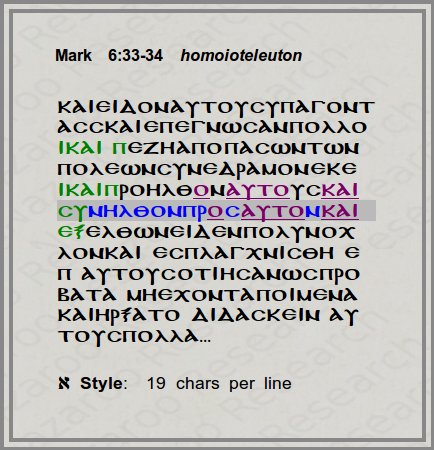
KΑI ΕIΔON ΑΥTOΥΣ ΥΠΑΓONTΑΣ
KΑI ΕΠΕΓNΩΣΑN ΠOΛΛOI
KΑI ΠΕZH ΑΠO ΠΑΣΩN TΩN
ΠOΛΕΩN ΣΥNΕΔΡΑMON ΕKΕI
KΑI ΠΡOHΛΘON ΑΥTOΥΣ
KΑI ΣΥNHΛΘON ΠΡOΣ ΑΥTON
KΑI ΕΞΕΛΘΩN ΕIΔΕN ΠOΛΥN OXΛON
KΑI ΕΣΠΛΑΓXNIΣΘH ΕΠ ΑΥTOΥΣ
OTI HΣΑN ΩΣ ΠΡOΒΑTΑ MH ΕXONTΑ
ΠOIMΕNΑ KΑI HΡΞΑTO ΔIΔΑΣKΕIN
ΑΥTOΥΣ ΠOΛΛΑ...And they saw them going,
and (the) people knew them,
and they ran on foot from all the towns,
and got there ahead of them,
and they gathered together to Him,
and leaving (the boat) He saw a huge crowd,
and he had compassion on them, because
they were like sheep without a shepherd;
and he began to teach them many things.
Here we have started a new line for each clause beginning with KΑI, as early amateur copyists commonly did, copying clause by clause. One instantly gets a sense of the frequency with which Homoioarcton (similar beginning) type errors could occur, due to Mark's simple narrative style. Almost every 5th or 6th line, features present themselves in a way to invite disaster.
include both lines: + και συνηλθον προς αυτον (/αυτου[ς]) - A, K, D, Π, f13~, 1009 1010 1071 1195 1216 1230 1242 1365 1546 1646 2148 2174 (1253, 1344), & Maj. of Greek MSS, it f, (q), syr h, Aeth
omit line 6 (only): - και συνηλθον προς αυτον - א, B, L, , 892, 1241, + 13 lectionaries (!)
omit line 5 (only): ( - και προηλθον αυτους ) - D greek, 28, 700 it b
the 6th line (underlined) is dropped by Aleph, B, critical Greek texts, and modern versions.
Here both a similar beginning and ending (and middle!) of two consecutive lines has caused the scribe's eye to slip and drop a line from the ancestor of Vaticanus and Sinaiticus. These two manuscripts stand alone (along with the 'usual suspects', a handful of lesser Alexandrian witnesses), against the overwhelming evidence for inclusion of the verses from all other text-types and witnesses (early fathers, versions etc.)
The alternate and independant, but identical type of error by Codex D underlines both how easily such errors happened and the difficulty early scribes had catching them before they were propagated into the textual stream.
Neither line adds anything to the narrative, and they could not have been concocted by copyists. They simply reflect the all-too-common and well documented long-windedness and redundancy of Mark's natural style.
Yet moronically, almost all modern versions follow the painfully obvious error of the 'two oldest and bestest manuscripts' against all other textual evidence, and common sense.
Nothing is really lost by the adoption of either reading, except of course the reputation of the Alexandrian scribes, and the credibility of modern Bible editors.
Mark 8:26-27 (traditional text)
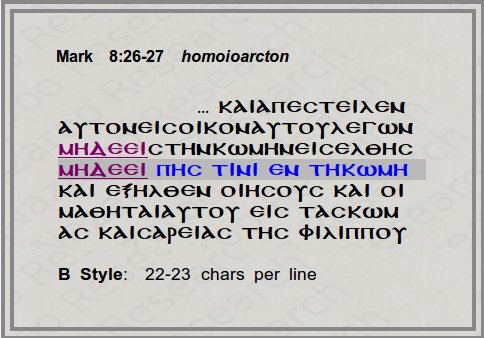
...KΑI ΑΠΕΣTΕIΛΕN
ΑΥTON ΕIΣ OIKON ΑΥTOΥ ΛΕΓΩN
MHΔΕ ΕIΣ THN KΩMHN ΕIΣΕΛΘHΣ
MHΔΕ ΕIΠHΣ TINI EN TH KΩMH
KΑI ΕΞHΛΘΕN O IHΣOΥΣ KΑI OI
MΑΘHTΑI ΑΥTOΥ ΕIΣ TΑΣ KΩMΑΣ
KΑIΣΑΡΕIΑΣ THΣ ΦIΛIΠΠOΥ
...And he sent
him away to his home, saying,
"Nor into the town enter,
Nor tell anyone in the town."
And Jesus went on with his disciples,
to the villages of Caesarea Philippi;
INCLUDE LINE: + A C K X Δ Π 33 700 (892) 1009 1010 1071 1079 1195 1230 1241 1242 1253 1344 1365 (1546) 1646 2148, Byz (Majority of MSS), Lect (all Lectionaries), syrp,h, cop(bo), goth, Aeth, Diatess.a,(p). (D), it(c),d,(q), (Θ), f13, (565), (1216, 2174), (arm), geo A, it(s),aur,b,f,(ff2),(i),l vg geoB, (124), syrh-mg.
OMIT: ( - MHΔΕ ΕI ΠHΣ TINI EN TH KΩMH) - א, B, L, f 1, syr a, copsa,bo,fay, geo1, (itk)
The scribe copies the first line beginning with 'MHΔΕ', then looking back at his exemplar fails to notice TWO lines starting with 'MHΔΕ' and continues from 'KΑI' (in line 4). The similar content in both lines doesn't help either. The error could be made multiple times from the same poorly laid out mastercopy, and once in the transmission stream could be duplicated further. Alexandrian editing practices ensured that this briefer reading would find its way into other copying streams via 'mixture'.
Once again, the shared omission by Aleph/B suggests either a common ancestor, or else a common set of readings by which such manuscripts were corrected by the copyists in the scriptorium where the two were made. But the very argument for a common ancestor identifies this as an error, not the original text (original readings do not distinguish text-types).
Instead of noting the obvious, modern versions follow their blind guides and the critical text of Westcott/Hort. They mistake the identification of an early intermediary text as the original text. Early intermediary texts by definition and nature must contain errors, and these are often identifiable. When errors can be identified, they should not be adopted as though they were original readings.
Mark 9:49-50 (traditional text)
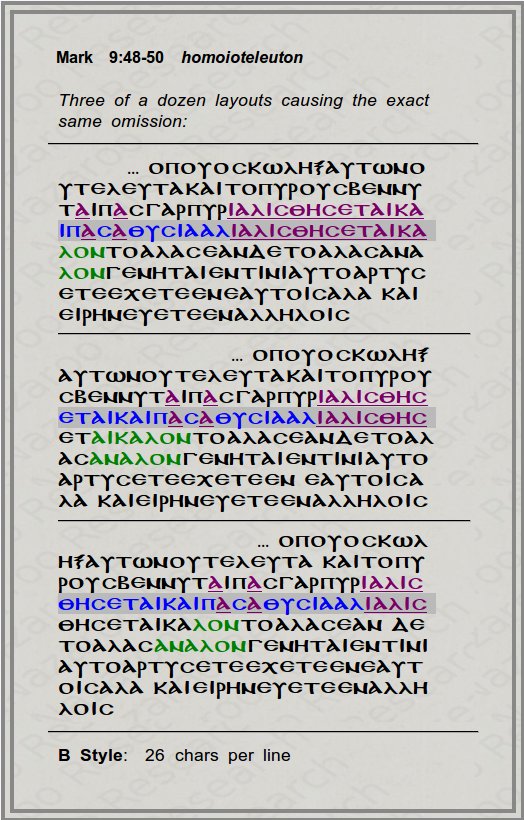
... ΠΑΣ ΓΑΡ ΠΥΡI ΑΛIΣΘHΣΕTΑI
KΑI ΠΑΣA ΘΥΣIΑ ΑΛI ΑΛIΣΘHΣΕTΑI
KΑΛON TO ΑΛΑΣ ΕΑN ΔΕ TO ΑΛΑΣ
ΑNΑΛON ΓΕNHTΑI ΕN TINI ΑΥTO
ΑΡTΥΣΕTΕ ΕXΕTΕ ΕN ΕΑΥTOIΣ ΑΛΑ
KΑI ΕIΡHNΕΥΕTΕ ΕN ΑΛΛHΛOIΣ
For everyone with fire (will be) salted
And every sacrifice with salt salted.
good (is) salt; but if the salt has lost its
saltness, how will you season it? Have
salt in yourselves, and be at peace with
one another."
INCLUDE LINE: A (C) K (X) (Θ) Π PSI 28 892 1010 1071 1079 (1195) 1216 1230 1241 1242 1253 1344 1365 1646 2148 2174 (1009 1010c 1546 Lect303,1127c) Byz (Majority of MSS), Lect (Lectionaries), itf,l,q vgcl (vgww) syrp,h cop(bo) goth aeth Diat. (D) it(a)b d ff2 i (itaur,c,k)
OMIT: (א), B, L,(W) Δ f 1, f 13, 28* 565 700 syr s, copsa,(bo), arm geo, (Diata-part)Here we have the alternate error, the similar ending of a line (Homoioteleuton) even more strongly than the beginning. The result is the same: loss of a line, and the usual suspect manuscripts, critics, and modern editions follow along, although this ancient error never even made it into the Latin via mixture or 'correction'.
The lesson is the same: Early mistake does not equal original text. Although the reading should be documented in any publication of the lost exemplar for Aleph/B, it should never have been adopted by those editing printed Bibles. Another case of misapplication of resources, allowing old errors to creep back into the working text.
We can see other potential trouble brewing as well, when the word "salt" appears five times in a few clauses. But we don't expect to see every potential case of haplography actually occur in the fragmentary samples of the textual stream that we now possess.
Mark 10:7 (Traditional text)
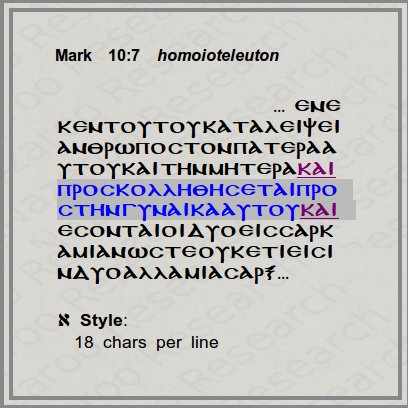
... ΕNΕKΕN TOΥTOΥ KΑTΑΛΕIΨΕI
ΑNΘΡΩΠOΣ TON ΠΑTΕΡΑ ΑΥTOΥ KΑI THN MHTΕΡΑ
KΑI ΠΡOΣKOΛΛHΘHΣΕTΑI ΠΡOΣ THN ΓΥNΑIKΑ ΑΥTOΥ
KΑI ΕΣONTΑI OI ΔΥO ΕIΣ ΣΑΡKΑ MIΑN ΩΣTΕ OΥKΕTI
ΕIΣIN ΔΥO ΑΛΛΑ MIΑ ΣΑΡΞ ...
'For this reason a man shall leave his father and mother
and be joined to his wife,
and the two shall become one flesh.' - So no longer
are they two but one flesh. ...
INCLUDE LINE: ... All other Uncials, Byz (all other cursives), Lect (all Lectionaries), all other versions, all other patristic evidence
OMIT: (א), B, ψ 892* syr s, gothThere it is again, this time likely from an older single-column papyrus with its wider columns:
similar start of line (Homoioarcton), resulting in the loss of the third line here.No doubt this was an early boo-boo. And it was quickly corrected and/or prevented from entering all the surviving streams of transmission...
- except, of course, the two Alexandrian MSS and a handful of followers: critics and modern versions numbly strike out the line.
It should be noted that the diverse clustering of the textual support between cases (as well as variations like length of line) indicate that these omissions come from different times and places.
This plainly demonstrates that at least some of these omissions cannot be the original text. But it IS possible that NONE of the omissions are original.
Mark 11:8 (Traditional text)
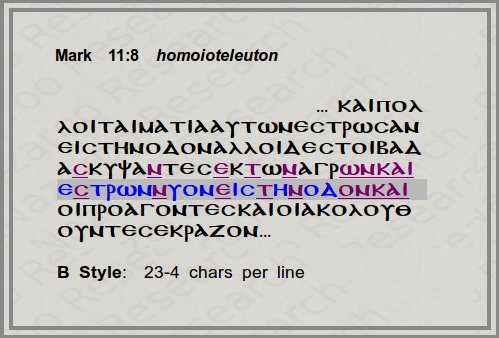
... KΑI ΠOΛΛOI TΑ IMΑTIΑ
ΑΥTΩN ΕΣTΡΩΣΑN ΕIΣ THN OΔON
ΑΛΛOI ΔΕ ΣTOIΒΑΔΑΣ KΥΨΑNTΕΣ ΕK TΩN
ΑΓΡΩN KΑI ΕΣTΡΩNNΥON ΕIΣ THN OΔON
KΑI OI ΠΡOΑΓONTΕΣ
KΑI OI ΑKOΛOΥΘOΥNTΕΣ
ΕKΡΑZON ΩΣΑNNΑ ΕΥΛOΓHMΕNOΣ
O ΕΡXOMΕNOΣ ΕN ONOMΑTI KΥΡIOΥ
and many, their garments
(they had) spread on the road,
but others spread leafy branches
which they had cut from the fields
and spread on the road.
and those who went before
and those who followed cried out,
"Hosanna! Blessed is he
who comes in the name of the Lord!"
The UBS-2 (1968) text doesn't even give notice that they have deleted a line from the traditional text here, and so the textual evidence must be sought elsewhere (for instance from W/H's Introduction of 1882, or Tischendorf's 8th ed.). But this section of Mark is so loaded with duplications of phrase that it is a wonder there were not many more mistakes and textual variants. The style of prose of the rest supports the inclusion of the phrase, not its exclusion.
Its easy to see here how the scribe, already fatigued by having to work with a 'wordy' Byzantine text-type, went completely cross-eyed and lost a line out of this cluster. What is ironic is that the scribe drops a line on the first "KAI", and doesn't even make it to the next line, where an even greater potential haplography hazard awaits.
Again, nobody in the Alexandrian stream was going to pick up the pieces here, And we could have predicted that critics would just close their eyes and hope the shorter text would at least remove some of the headache.
Modern versions follow along, like donkeys tracking a retreating carrot on a stick. But not even telling the reader of the deletion of a half-verse must be labelled a dubious practice.
Mark 11:25-26 (Traditional text)
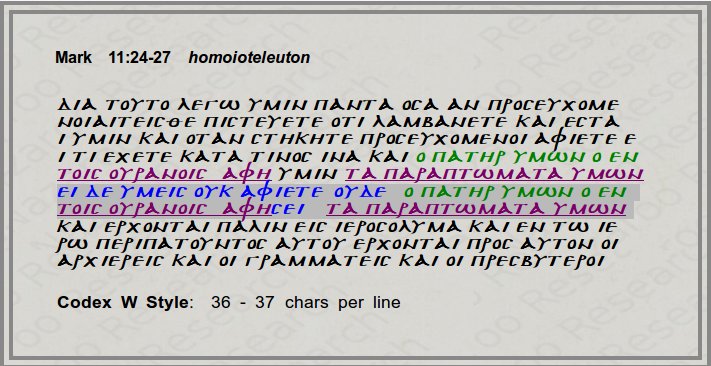
.........και οταν στηκητε προσευχομενοι αφιετε
ει τι εχετε κατα τινος ινα και ο πατηρ υμων ο εν
τοις ουρανοις αφη υμιν τα παραπτωματα υμων
ει δε υμεις ουκ αφιετε ουδε ο πατηρ υμων ο εν
τοις ουρανοις αφησει τα παραπτωματα υμων
And when ye stand praying, forgive,
if ye have ought against any: that your Father
which is in heaven will forgive you your trespasses.
But if ye do not forgive, neither your Father
which is in heaven will forgive your trespasses.
Include Line: A (D) K X Θ Π (C f1 1079 f13 33 1009) 28 1010 1071 1195 1230 1241 1242 (1253) 1344 1365 1546 2148 2174 Byz Maj (Majority of all continuous MSS) Lect. (l-10/12/32sm/69/70/80/303/333/374/313/1579) it-a/aur/b/c/d/t/ff2/(i)/q/r1 Vg Syr-P/H Copt-Bo(mss) Goth Eth Diat. (Cyprian) Augustine.
Omit: א B L W 565 700 892 1216 it-k/l vg(ms) Syr-S/pal copt-Sa/Bo arm geoOne could not ask for a more complete nor harsher example of homoioteleuton, combined with homoioarcton, combined with another whole pair of lines with both. Its a recipe that demands disaster.
And disaster strikes in Egypt, right where scribes are most likely to be sloppy, and least likely to catch the boner, and even less likely to correct it, even if spotted. After all, its a chance to jettison some Markan redundancy free of charge.
Nor do modern editors miss the opportunity: like their ancient counterparts in Egypt, they lop the whole verse out, in spite of it being the greatest example of a scribal error by omission that we can find.
Everything is in place, from the longer length of line to the early Egyptian witnesses, and all nod their head in agreement that the verse is better left unwritten, and unspoken: The threatening content alone is offensive enough for all to hope its just an elaborate scribal hoax by some hell and damnation preacher.
All 'modern' versions expunge the pesky verse, making those longwinded Sunday sermons just that little bit shorter and more pleasant, so we can proceed to the afternoon horse-racing.
Mark 12:33 (traditional text)
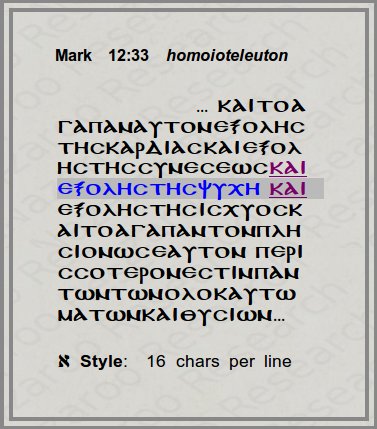
KΑI TO ΑΓΑΠΑN ΑΥTON ΕΞ OΛHΣ THΣ KΑΡΔIΑΣ
KΑI ΕΞ OΛHΣ THΣ ΣΥNΕΣΕΩΣ
KΑI ΕΞ OΛHΣ THΣ ΨΥXH
KΑI ΕΞ OΛHΣ THΣ IΣXΥOΣ
KΑI TO ΑΓΑΠΑN TON ΠΛHΣION
ΩΣ ΕΑΥTON ΠΕΡIΣΣOTΕΡON ΕΣTIN
ΠΑNTΩN TΩN OΛOKΑΥTΩMΑTΩN KΑI ΘΥΣIΩN
and to love him with all the heart,
and with all the understanding,
and with all the soul,
and with all the strength,
and to love one's neighbour as oneself,
is much more than all whole burnt offerings and sacrifices."
INCLUDE LINE: A, 087, f13, 33, 1424, etc. Byz (i.e., Majority text-type, uncials & cursives), Latin, syrp,h cop(sa,bo), goth, etc.
OMIT: א , B (no umlaut), L, W Δ Θ Ψ f 1, 28* 565 892 1241 1342 2542, pc, syr s, cop(sa,bo),NOTES: Assorted Latin MSS attempt to harmonize the passage with the LXX and other gospels without uniformity or success (e.g., Deut. 6:5, Mk 12:30, Lk 10:27, Matt. 22:37). Variants in these other places are instructive.
Tregelles (1861) brackets it, Hort (1882) adopts Aleph/B without even a note, UBS (1965) follows but mentions no variant at all. Modern versions follow suit using the UBS text, without apparently even knowing they have dropped a half-verse from the Bible.
Of course you didn't expect an Alexandrian scribe to get this one right did you?
Well, this is an obvious accident waiting to happen. And it did: to the whole Alexandrian geneaological tree. But not a single monkey climbed back up to replace the lost floorboard in the clubhouse.
Apparently 'souls' are an expendable item in Egypt.And yet of all places, this would have been the one we would have hoped the modern versions would dare not follow brain-dead critics. And yet they did, right into the soul-less land of Mordor.
Mark 14:19 (Trad. Text)
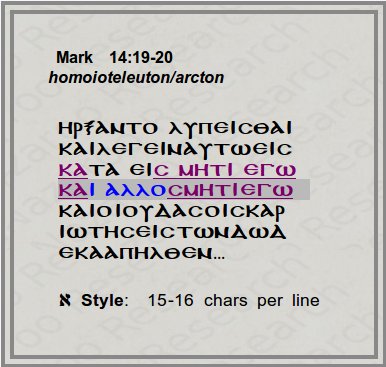
HΡΞΑNTO ΛΥΠΕIΣΘΑI
KΑI ΛΕΓΕIN ΑΥTΩ
ΕIΣ KΑTΑ ΕIΣ MHTI ΕΓΩ
KΑI ΑΛΛOΣ MHTI ΕΓΩ
They began to be sorrowful,
and to say to him
one by one, "Not I?"
and yet another, "Not I?"
INCLUDE LINE: D, Θ, f1, 700, Byz (Majority of all MSS), it(a, d, f, ff2, i, k, q), Sy-Hmg, arm, geo, Or, Gre, Bois, Trgmg (eimi/kai) A, 28 267 517 892 954 1071 1424 1675 pc2 (+kurie/rabbi) A, 267 (subst. just [kai] o allos) c, 579 etc.
OMIT: א , B (this time with an umlaut!), C, L, P, W, Δ, ψ 828(~f13), 1342, 2786, al125, Latin(aur, l, vg), Syr, Cop
Lacuna: 33, B: umlaut! (p. 1299 B, line 28) eis mhti egw, o` de. eipenAgain one will look in vain for any documentation in the UBS Greek text, or even a footnote mentioning the omission in modern versions.
This bit of superfluous Markan wordiness was bound to be excised by a trigger-happy Diothores ('overseer/corrector') at some point. You knew no Alexandrian Editor would let this stand for long. It would just go against every editing impulse he spent his whole life mastering. And how could textual critics and modern versions do otherwise?
Yet no sensible copyist could have created this alleged 'insertion'. We would also have to account for this reading dominating the Byzantine tradition (Majority of MSS). To be a mere gloss, it would require five consecutive improbabilities:
(1) We have to imagine that some copyist or commentator added this highly unlikely line in the margin, which adds nothing to the narrative or dialogue at all, except clumsy wordiness. Since there is no theological motive, it must be sheer stupidity.
(2) Yet another equally and incredibly stupid copyist would be required to turn it from the margin of one manuscript into the very text of another.
(3) The 'bloated' manuscript would have to be chosen by copyists to be a winning master-copy. Which means its text (and representatives) ought to reflect the Byzantine text-type, not the Alexandrian.
(4) Both it and most subsequent copies must have passed multiple examinations for such common errors by correctors and public readers, even in places like Alexandria, Antioch and Caesaria.
(5) These 'bloated' copies must have been the exemplars of choice for the entire Byzantine text-type, resulting in a 2,000 to 1 preponderance of the reading in the majority of subsequent MSS.
Yet viewed as original to Mark, it reflects just exactly his expected wordy style, which constantly includes superfluous and often incidental details that all subsequent editors (including Luke and Matthew) occasionally feel compelled to eliminate for the purpose of efficient story-telling and good grammar.
Even Weiland Willker comments wryly in his exhaustive online textcritical commentary:
"The omission could be due to haplography: mh,ti evgw, - mh,ti evgw,. This is probably true at least in part, note the 125 Byzantine MSS!
The longer text is rather awkward, since the "saying to him one after another" includes already the 'allos' and allows no continuation (Hoskier: "very pleonastic clause", "absolutely Mark-like"). Perhaps this was the reason for the omission? On the other hand the words could have been added as an intensification or enhancement (so Güting TC Mark, 2005, p. 657).
The reading of A, f13 et al. is a (partial) harmonization to Mt (note the 'rabbi', by A). The reading of 579 makes good sense. "Is it me or another one?"
Note that both Mt and Lk have eimi against Mk (Minor Agreement).
Rating: 1? (NA probably wrong)
External Rating: - (indecisive) (after weighting the witnesses)"- W. Willker, online comm.
To this we can only add that the words "could also be an original intensification or enhancement" (ala' Guting), with Mark intending to point an accusing dramatic finger at Peter or more likely, Judas.
But if even textual critics cannot decide whether the line is original or not, why delete it at all?
Mark 14:68

O ΔΕ HΡNHΣΑTO ΛΕΓΩN OΥTΕ
OIΔΑ OΥTΕ ΕΠIΣTΑMΑI ΣΥ TI ΛΕΓΕIΣ
KΑI ΕΞHΛΘΕN ΕΞΩ ΕIΣ TO ΠΡOΑΥΛION
KΑI ΑΛΕKTΩΡ ΕΦΩNHΣΕN
KΑI H ΠΑIΔIΣKH IΔOΥΣΑ ΑΥTON
But he denied it, saying,
"I neither know nor understand what you mean."
and he went out into the gateway,
and the rooster crowed.
and the maid saw him,...
INCLUDE LINE: A, C, D, Δ Θ ψ corr., 067, f1, f13, 33, 1424, Byz (Majority of all continuous MSS), Latin, Syrp,h, samss, bomss, goth, Eus. etc. (also add euthews) 517, 954, 1424, 1675, pc11
OMIT: א , B (no umlaut), L, W, ψ*, 222, 579, 892, c, SyS, (samss), bo, WH, NA25
Here even the UBS-2 text dares go no further than [single-bracketing] the line as undecided/doubtful. Yet many a modern version stumbles into this trap.
It seems unreasonable to think even an inexperienced Alexandrian scribe doesn't know what a rooster is, and so find himself compelled to expunge the foreigner.
But can any modern Bible editor/translator even hope to present a credible argument that this Markan prophecy-fulfilling line and key plot-element was not an original part of Mark's Gospel? Please spare us the effort.
Mark 15:27-29 (Traditional Text) - homoioteleuton/arcton
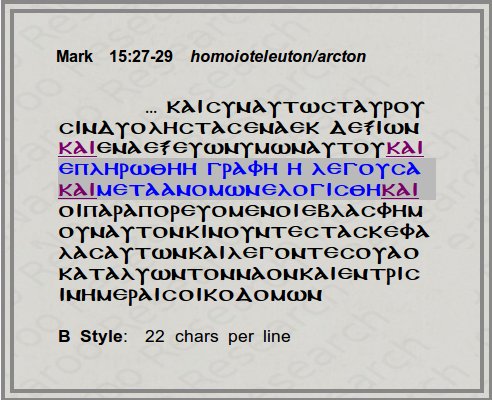
και συν αυτω σταυρουσιν δυο ληστας
ενα εκ δεξιων και ενα εξ ευωνυμων αυτου
και επληρωθη η γραφη η λεγουσα
και μετα ανομων ελογισθη
και οι παραπορευομενοι εβλασφημουν
αυτον κινουντες τας κεφαλας αυτων
και λεγοντες ουα ο καταλυων τον ναον
και εν τρισιν ημεραις οικοδομωνAnd with him they crucify two thieves;
the one on his right hand, and the other on his left.
And the scripture was fulfilled, which saith,
And he was numbered with the transgressors.
And they that passed by railed on him, shaking their heads,
and saying, "Ah, thou that destroyest the Gospel of Mark,
and reconstruct it in three editions,..."
INCLUDE VERSE 27: Include Verse 27: K L P Δ Θ Π 0112 0250 family 1, family 13, 28 33 565 700 892 1009 1010 1071 1079 1195 1216 1230 1241 1242 1253 1344 1365 1546 1646 2148 2174 Byz Maj (Majority of continuous MSS) lect.-10/211/883/1642/ it-aur/c/ff2/l/n/r1 Vg Syr-P/H/Pal Cop-Bo(mss) Goth Arm Eth Geo Ps.-Hyppolytus(vid) Origen Euseb.Can.(mss) Vigilius(vid)
OMIT: א , A B C D X Ψ Lect. it-d/k Syr-s Cop-Sa/Bo(mss)/fay(vid) Eus.Can.(txt) Ammon.
These passages are also known as the "KAI" passages for a reason:
Its Mark's monotonous habit of starting every sentence, nearly every clause, with "KAI".
Just look at what occurs previously in the narrative:
15:16 ...KAI 17 KAI.....KAI... 18 KAI..... 19 KAI.....KAI.....KAI... 20 KAI.....KAI.....KAI... 21 KAI..... 22 KAI..... 23 KAI..... 24 KAI..... 25....KAI... 26 KAI... 27 KAI......KAI... 28 KAI..... 29 KAI.....KAI... 30 31....KAI... 32....KAI.....KAI...
The sheer frequency of this stylism puts experienced copyists on guard, but of course even the best scribe will eventually succumb to a few of these common errors of homoioarcton with KAI.
And so it was inevitable that the Alexandrian tradition would also pick up a few of these "KAI-droppings", and pass them on to infect others.
From there as expected, the self-appointed correctors of the 4th century adopted the gaffe.
Modern editors of the critical text don't hesitate to pounce on this obviously early reading (mistake), incorporating into the reconstruction of the horrible accident that is called the "Alexandrian Text-type".
Unfortunately, as an 'Agreement in Error', this omission is no candidate for the original text of Mark, who wrote in Rome, not Alexandria, and whose text is better preserved by the Latins who Mark evangelized.
'Modern' versions, oblivious to the real nature of the critical Greek text, unanimously omit the verse, in spite of the loud warning in the apparatus of UBS, including the ASV, NAS, NIV, RSV, NEB, etc.
What will it take to get the text of Mark restored to its purity?
The Scripture was certainly fulfilled, but we'll never hear of it if we follow the empty-headed choices of modern editors of the NT.
Summary for Mark
Well, that's nearly ten examples found just by a brief glance over the UBS critical text, and using their own footnotes. What are the editors of modern versions thinking?
Note that none of these examples can be interpreted as 'interpolations' by any rational argument. They cannot be 'scribal glosses' accidentally copied into the text from the margin, nor can they be deliberate edits, for none of them add any theological, apologetic, dialectic, or doctrinal content at all to any of the passages. They cannot be imaginative inventions or elaborations of the texts in which they are found, nor can they be remotely construed as 'harmonizations' either to the immediate context or Synoptic parallel passages. One will look in vain for any better explanation than simple haplography here, and this would go for about 200 such cases sprinkled throughout the New Testament.
The 19th century naive and mechanical application of the Textual Rule of Griesbach, "Prefer the Shorter Reading" is simply nonsense in these cases.
There are no plainer cases for errors than blatant haplography examples like these.
The Problem with Mark 7:19
The Problem with this particular scripture is complicated by two layers of confusion.
The first concerns the Greek text.
While the Traditional (Majority/Received) Greek text of Mark reads as follows:
"...παν το εχωθεν εισπορευμενον εις τον ανθρωπον
ου δυναται αυτον κοινωσαι.
οτι ουκ εισπορευεται αυτου την καρδιαν
αλλ' εις την κοιλιαν,
και εις τον αφεδρωμα εκπορευεται,
καθαριζον παντα τα βρωματα."The Hort/Nestle/UBS text however, reads καθαριζων, ('[he was] purifying'), thus ending the quotation after εκπορευεται, and setting off the last phrase as Mark's explanation in the narrative (rather than a continuation of Jesus' speech). This reading is only supported by three manuscripts, Codex Sinaiticus (Aleph), Vaticanus (B), and Alexandrinus (A), against the entire corpus of thousands of other MSS.
"...παν το εχωθεν εισπορευμενον εις τον ανθρωπον
ου δυναται αυτον κοινωσαι.
οτι ουκ εισπορευεται αυτου την καρδιαν
αλλ' εις την κοιλιαν,
και εις τον αφεδρωμα εκπορευεται."
- καθαριζων παντα τα βρωματα.What is the significance of the change? It represents a stage in the Romanization (Gentilizing) of the New Testament, in which early editors tried to remove the embarrassing "Jewish" elements and downplay the Jewish origins and teachings of Jesus and the Apostles, in the process of making Christianity the state religion of the Roman Empire.
We can see the significant impact of the alteration of a single letter in one word in the resulting translation:
The Traditional text reads:
"...everything from outside entering into the man
is not able to make him 'common';
because it doesn't enter into his heart,
but into the intestine,
and into the toilet passes,
purifying [the man] of all the foods..."
The Traditional text is straightforward, and simply states the obvious, that even if food temporarily enters a man, it also leaves again, restoring a man's purity (e.g. through fasting). There is no "magical" meaning attached to Jesus' words, nor is it needed, in order to make sense of the teaching.
The UBS text reads (and mistakenly translates):
"...everything from outside entering into the man
is not able to make him 'common';
because it doesn't enter into his heart,
but into the intestine,
and into the toilet passes."
- [he was ] purifying all foods...
Naturally, all 'modern' versions, based on these 4th century Roman heavily edited ecclesiastical texts make Mark say in the narrative that Jesus had "declared all foods clean".
But this not only rests on shakey textual ground, but it rests also on a super-imposed meaning based on Roman Catholic popular teaching.
When we look at the complete context, the correct reading is obvious:
(1) Jesus lived as a law-abiding Jew during His public ministry.
(2) Had Jesus and His disciples been actually breaking the Jewish Food Laws, the Pharisees would hardly have quibbled about hand-washing, but would have accused Him (as they later did) of breaking with Jewish Law (Torah).
But the worst the Pharisees can observe is that some of Jesus' disciples forgot to wash their hands.
(3) Had Jesus taught that "all foods were clean" during His public ministry, all the Apostles would have long known of it, and Peter would have no need of any "vision" in Acts to clarify things.
(4) Nor would the Apostles in council have needed to review the matter and issue a simplified set of food-laws for Gentiles, if Jesus had taught that JEWS did not need to keep the Food Laws.
This is just another case of 19th century textual critics running after and idolizing a handful of 4th century manuscripts over and against the traditional text of the New Testament used by Christians for a thousand years.
Mark 7:19 is a good example of what happens when Protestants goof off.
Nine Cases of
Haplography in Luke
Luke 4:5 (traditional text)
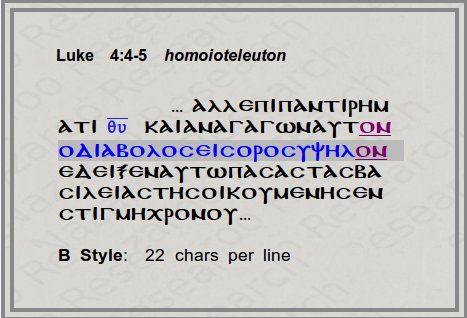
...KΑI ΑNΑΓΑΓΩN ΑΥTON
O ΔIΑΒOΛOΣ ΕIΣ OΡOΣ ΥΨHΛON
ΕΔΕIΞΕN ΑΥTΩ ΠΑΣΑΣ TΑΣ Β-
-ΑΣIΛΕIΑΣ THΣ OIKOΥMΕNHΣ
ΕN ΣTIΓMH XΡONOΥ ...
And [the devil] took him up,
into a high mountain,
[and] showed him all the
kingdoms of the world
in a moment of time...
INCLUDE LINE: A, Δ Θ ψ 0102 33 579 1342, Byz, Maj (Majority of all continuous MSS), ital(d, f, ff2, l, q), Sy-P, Sy-H, bomss, goth
(add: lian) f13, c, r,1, vgmss, samss, D, 788 (~f13)
INCLUDE PART:
(drop: ho diabolos) א c1, D, W, f1, 700, 2542, pc, e, samss, bopt, arm, geo
(only: ho diabolos) aur, b, g1, vgmss Sy-S
OMIT: א*, B (no umlaut), L, 1241, pc (samss), bopt, NA27
Completely undetectable in the English translation, but a very easy haplography mistake to make from the Greek text.
There is little that is credible in any proposal that a scribal editor might have simultaneously added the Nominal Subject (i.e., an unnecessary filling in of the 'zero-anaphora'), as well as a locative indirect adverbial phrase, all in the same emmendation of the text.
Rather, as with most haplography errors, the omission is purely accidental, catching the Subject and the unrelated predicate phrase in one clumsy skip & chop. That the result is still readable is merely unlucky, helping to hide the boo-boo , but it explains well how it was missed and subsequently copied. Mistakes that badly garble the text are far more likely to be caught and cured before a manuscript leaves the scriptorium. This one flew under the radar easily.
The unusual activity of many 3rd-4th century correctors simply reflects the extent of the confusion caused by the initial haplography, which accidentally removes TWO sentence elements. Even in the 4th century this blunder was suspicious, and the omission of the entire line was not plausible.
A footnote will also be impossible to find in modern versions, as the UBS-2 text offered nothing in the apparatus on this variant either: Its another one of the 'secret' changes, - variants "of no significance for translators" (but adopted anyway)...unless they happen to be interested in what the original text actually was.
Again Willker is instructive:
Parallel: Luke 4:5 / Matthew 4:8
The support is not good for the omission and it is slightly awkward without the words ("led him up" to what?). h.t. is possible (ON - ON), note the C1 correction of 01.
The variety of the readings indicates a secondary cause though. Very probably from Mt (so Weiss).
IQP's Crit. ed. has the Matthean "ho diabolos eis oros [[upsylon lian]] with double brackets indicating doubt that text was present there. This is odd, because both Mt and Lk have upsylon. Fleddermann ("Q - A reconstruction", 2005) has "ho diabolos eis oros upsylon" without "lian".
- W. Willker, Textual Commentary
Willker recognizes the probable Haplography error, and is suspicious of reconstructions that drop words with little or no textual support.
Luke 5:38-39

...ΑΛΛΑ OINON NΕON
ΕIΣ ΑΣKOΥΣ KΑINOΥΣ ΒΛHTΕON
KΑI ΑMΦOTΕΡOI ΣΥNTHΡOΥNTΑI
KΑI OΥΔΕIΣ ΠIΩN ΠΑΛΑION ΘΕΛ-
-ΕI NΕON ...But new wine must be
put into fresh wineskins,
and both are preserved;
And no one after drinking old
desires new;...
INCLUDE LINE: A, C, D, R, Δ Θ ψ, f13, Maj, Latt, Sy, bomss, goth, [Trg] Byz, Maj (Majority of all continuous MSS), D, it, Sy-P, MarcionA
OMIT LINE: P4 (200 CE), אCorr1, B, L, W, f1, 33, 131, 157, 579, 700, 1241, pc2, Co
PARTIAL LINE: א *: (+ ballousin), W: (+ ballhtai) pc = 5, 301C, (P75vid)
This incidental remark is easy to understand as from a wordy Markan/Q source, but impossible to fathom as a deliberate interpolation by editors or copyists (or even as an addition by Luke). The "both" naturally implies both wine and container, not for instance "old" and "new" wines. But no Christian editor would be concerned with such matters, and certainly not an Evangelist like Luke. There is no advantage for Christian dogma in adding this phrase.
It seems more likely that Luke found this in his typically wordy Markan/Q source, and if anything he might have been inclined to simplify and expunge it himself. But just because Luke might have expunged it on second or third pass, does not mean that we should do so. Leaving things like this in place gives us a much more accurate picture of the original sayings of Jesus. Simplification and 'smoothing' is the task of pastors and preachers, not restorers of the NT text.
The typical word-line length and the double trap (homoioarcton/homoioteleuton) in close proximity is a dead giveaway for considering this candidate as a haplography error.
Luke 9:55-56 and more...
'and said, Ye know not what manner of spirit
ye are of: For the Son of Man has come not to destroy men's lives, but to save them.' (homoioarcton: kai..., kai... )Seven more cases can be checked by the reader themselves using the UBS or WH text:
Luke 12:39 "he would have watched and" (homoioteleuton: kai, ...kai, )
Luke 17:9 "him?! I think not!" (homoioarcton: ou.., ou.. )
Luke 17:24 "in His day" (homoioteleuton: anthropou, ...autou, )
Luke 19:45 "therein and them that bought" (homoioteleuton: ...ountaV, ...ontaV)
Luke 22:68 "Me, nor let Me go" (homoioteleuton:...qhte, ...shte)
Luke 23:23 "and of the chief priests" (homoioteleuton:...wn, ...wn)
Luke 24:42 "and of an honeycomb" (homoioarcton: kai..., kai...)
Nor can these 'oversights' by the UBS editors be in any way accidental.
In fact, (besides leaving out footnotes entirely sometimes), the critical apparatus has been deliberately encumbered in order to actually DISGUISE these cases of Haplography, so that they are more difficult to spot:
The editors systematically include the previous word of every omitted portion (needlessly), making it more difficult to see exactly what was left out, and why, because the similar endings and beginnings must now be hunted down, recognized, and reconstructed by the reader.
(more to follow...)
Luke 9:55-56
(homoioarcton: kai..., kai... )
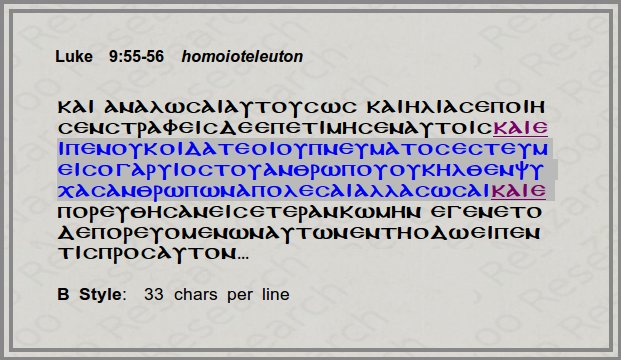
και ειπεν ουκ οιδατε οιου πνευματος εστε
υμεις ο γαρ υιος του ανθρωπου ουκ ηλθεν
ψυχας ανθρωπων απολεσαι αλλα σωσαι
και επορευθησαν εις ετεραν κωμην
and [Jesus] said, "Ye know not what manner of
spirit ye are of: For the Son of Man has come
not to destroy men's lives, but to save them."
and they went to another village. But as they went...
INCLUDE LINE: D, K (Θ) Π ψ, 1079 1242 1546, Byz, Maj (Majority of all continuous MSS), it-aur/a/b/c/e/f/q/r/vg, Syr-C/P/H, Cop(Bo) Goth Arm Marcion Diat. Ambrose Epiph. Antioch. etc. (1195 1365 2148 2174 f1 f13 l-69)
OMIT LINE: P45,75 (200-250 CE), א Corr1, B, A, C, L, W, Δ Ξ , 28 33 565 892 1009 1010 1071 (1241) it -l Lect. Syr-S, Cop-Sa/Bo AEth, Basil Cyril-Jer, Jerome
Luke's smoother and easier to read Greek may have been copied in larger portions by scribes.
But in any case, at least FOUR identical letters similarly placed in a line is enough to allow the eye to skip when flitting back and forth from a long column of compressed letters to the copy. Any number of letters per line that would allow the "KAI E" to appear in a similar horizontal position would create the all too common hazard.
The textual evidence offered by the UBS-2 apparatus is blurred and made over-complex by the inclusion of variants from the previous verse and minor variants among the versions, making it all but useless even for establishing what the textual evidence actually is.
The readings of P45 and P75 give a weighty appearance, but once again prove too much. They are excellent evidence of a common exemplar for Aleph/B, by agreement in error, but this agreement in error only confirms thats what the reading really is: an early error that crept into the Alexandrian text-type preferred by the editors of Aleph/B.
Recommendation: Leave the verse in the text. Its clearly a beautiful example of a difficult teaching by Jesus to His apostles, and could hardly have been invented by later copyists sucking back wine and blacking out.
Luke 12:39
(homoioteleuton: -ai, ...kai, )
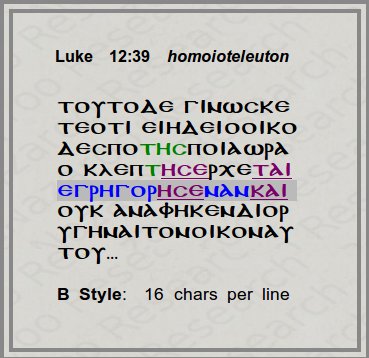
τουτο δε γινωσκετε
οτι ει ηδει ο οικο
δεσποτης ποια ωρα
ο κλεπτης ερχεται
εγρηγορησεν αν και
ουκ αν αφηκεν διορ-
-υγηναι τον οικον
αυτου ...
"But know this: that if
the master of the house knew
what hour the thief is coming,
he would have watched, and
not allowed his house
to be broken into."
INCLUDE LINE: א a, אc, A, B, K, L, P, W, X, Δ Θ ψ, 070, f1, f13, 28 33 565 700 892 1009 1010 1071 1079 1195 1216 1230 1241 1242 (1253) 1344 1365 1546 1646 2148 2174 Maj, Latt, Sy, bomss, goth, [Trg] Byz, Maj (Majority of all continuous MSS), Lect, ital(aur)/b/c/(f)/ff2/(l,q)/r1, (vg), syrp/h, Copt(sa)bo, AEth, Geo, Diatess., Basil, John-Damascus etc.
OMIT LINE: P75 (200 CE), א*, it(d)e/i, syrc/s, Copsa/ach, Arm, Marcion, Tertullian.
PARTIAL LINE: (D omits 'aphhken...autou').
Even Westcott/Hort rightly rejected this omission, favouring the traditional text (including the line). They at least recognized this for what it was. The Nestle'/UBS critical Greek texts however, mechanically follow every omission commited by either Aleph/B, striving to recover a lost ancestor, even when the omission is an obvious error.
The early evidence of the error (P75) combined with its virtual absence everywhere else only confirms the blunder, copied by Aleph.
Sadly, The translators of "modern" versions (NAS, NIV, NEB) still just don't seem able to get the difference between an early error, and an authentic candidate for the original text. They follow the academics and their lost exemplar off to nether-netherland.
Luke 17:9(-10)
(W) OU...(W) OU... (homoioarcton)
μη χαριν εχει τω δουλω εκεινω
οτι εποιησεν τα διαταχθεντα (αυτω)
ου δοκω ουτως και υμεις οταν ποιησητε
παντα τα διαταχθεντα υμιν
λεγετε οτι δουλοι αχρειοι εσμεν οτι
ο ωφειλομεν ποιησαι πεποιηκαμεν
"Does the servant have thanks for this,
that he did the things commanded (of him)?
I think not! So also you, when you do all
that has been commanded to you, confess,
'Profitless servants we are, since we have
merely done what we ought to have done.'. "
INCLUDE LINE: A, K, W, Δ Θ Π ψ, 063 28 565 700 892 1009 1071 1079 1195 1216 1230 1242 1253 1344 1365 1546 1646 2148 (2174) Byz, Maj (Majority of all continuous MSS), Lect., itc/s, Sy-H,Goth, Antiochius, etc.
(+autw) - D, f13, l547, it(aur/b/d/f/ff2/i/l/q/r1), vg, Sy-P,Geo2 Diatess.
OMIT LINE: P75 (200 CE), א , B, L, f1, 1010 1241 it(e), Syr-Pal, (arm), geo1, (+autw) X (comm.), ita, Syr-C/S, Cop-Sah/Boh, AEth, Cyprian
Its easy to see that what began as a simple homoioarcton omission, gained currency as an attractive reading. (There are actually 3 letters in a row forming the trap in the Traditional text).
Possibly opponents were targeting embarrassing phrases from the Gospels as early as the 2nd century. One can picture the quip: "Your Jesus himself confesses, 'I think not! '. Therefore he is no thinker!" etc.
Once an omission like this occurs, the inherent difficulty in the original reading strongly interferes with its restoration. The ellipsis is simply too convenient. Naturally when the initial variant fell into the hands of Alexandrian editors and correctors, the textual variants bloated as others adopted the 'lucky' omission for expediency, i.e., defensive/apologetic purposes.
Sadly, once again the critical Greek Text editors (WH, Nestle, UBS) adopt the Aleph/B reading without question, seeking the holy grail of an ancient (error ridden) ancestor. The REAL variant among the majority of manuscripts, namely the (autw) in the previous line, is not found in the textual apparatus, - we suspect because it is not sufficiently 'interesting'.
We suspect the translators of 'modern' versions however, have actually adopted this omission for expediency, not accuracy, like their ancient Alexandrian counterparts.
Luke 17:24
ωσπερ γαρ η αστραπη η αστρα-
-πτουσα εκ της υπ' ουρανον
εις την υπ' ουρανον λαμπει
ουτως εσται και ο υιος του
ανθρωπου εν τη ημερα αυτου
πρωτον δε δει αυτον πολλα
παθειν ..." - For as lightning that flashes
from one part under heaven to
another part under heaven, so also
will be the Son of Adam in His day.
-But first He must suffer many
passions..."
INCLUDE LINE: א A, K, L, W, X, Δ Θ Π ψ, 063 f1, f13, 28 565 700 892 1009 1010 1071 1079 1095 1216 1230 1241 1242 1253 1344 1365 1546 1646 2148 2174 Byz, Maj (Majority of all continuous MSS), Lect, itaur/f/q/r1, vg, Sy-(c/s)/p/h, Copt-bo, goth arm geo.
OMIT LINE: P75, B, D, it-a/b/d/e/i, Cop-SA
One too many "ou"s and a half-line is lost. Another classic case of homoioteleuton (similar ending).
The Editors of Aleph were more on the ball than those of B this time. B (Codex Vaticanus 1209) stands alone with D of all possible co-dependants. Perhaps this peculiarity reveals more frequent collusion or perpetuation of early mistakes than previously suspected. But nothing here suggests an original reading, or even a reading that predates circa 250 A.D.
What caused Westcott/Hort to follow B here, even without the support of Aleph? Probably his obsessive belief in the superiority of B no matter how far-fetched the reading. Not even Nestle or UBS-2 follows Hort here, and most 'modern' versions retain the traditional text, but not through any insight: they are simply following Nestle/UBS, and have no knowledge of yet another blunder by B or his exemplar.
P75 was unknown in Hort's day. Far from adding weight to the reading, the agreement of P75 only reveals its true character as a sloppy Egyptian copy prone to perpetuating accidental omissions. Neither the scribe nor the correctors' reputation is enhanced by such discoveries.
Luke 19:45
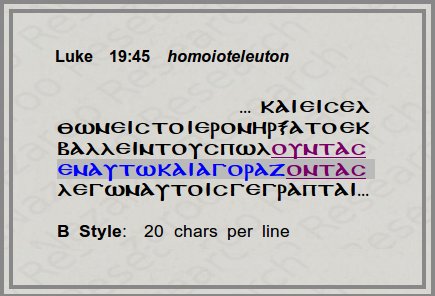
...και εισελ-
-θων εις το ιερον ηρξατο
εκβαλλειν τους πωλουντας
εν αυτω και αγοραζοντας
λεγων αυτοις γεγραπται...
Then He went
into the temple and began to
drive out those those who sold
in it, and those who bought,
saying to them, "It is written,..."
INCLUDE LINE: Byz, Maj (Majority of all continuous MSS), A, C, (D), R, W, Δ Θ ψ, f13,(28) 33, 157, 700, 2542, Lat(aur, f, vg), Sy-S, Sy-C, Sy-P, goth,
Include & ADD Matt. 21:12b: D, L, pc, it, vg(mss), Sy-H**, arm
OMIT LINE: א B, L, f1, 22, 579, 1241, pc, Sy-Pal, Co, geo, arabMS
(B: no umlaut)
Virtually all Uncials and Cursives include the line as original.
Aleph/B follow the omission, again providing evidence of at least the influence of a common ancestor through Agreement in Error. The minority reading again furnishes support for an accidental omission, not the original text.
The behaviour of D, L, etc. shows that scribes in the 4th and later centuries were willing to add material if that material was borrowed from another parallel passage. The usual culprits are guilty, but not the majority of copies.
Its easy to see how the omission makes an attractive reading, because it gets all those BUYING goods in the temple off the hook. In the altered text, only the SELLERS are driven out by Jesus: less damning, but unfortunately also less plausible historically.
The UBS text offers not even a footnote, and so naturally, all 'modern' versions based upon it exclude the phrase without even knowing it, including the ASV NAS NIV RSV NEB NBV and a few others.
This kind of systematic omission without documentation borders on fraudulent behaviour. Individuals who are purchasing a new Bible because they want updated language are simply not told the actual extent to which the text has been altered.
Luke 22:68
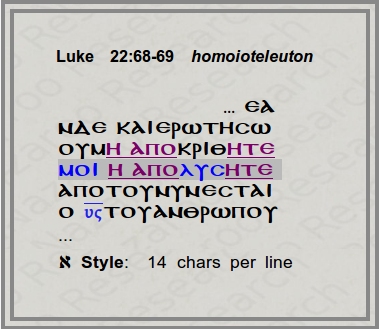
εαν δε και ερωτησω
ου μη αποκριθητε
μοι η απολυσητε
"And if I also question you,
You will by no means answer
me, nor let me go."
INCLUDE LINE: A, D, K, W, (X), Δ Π ψ, 063, f13, 28 565 700 (892) 1009 1010 1071 1079 1195 1216 1230 1242 1253 1344 1546 1646 2148 Byz, Maj (Majority of all continuous MSS), Lect, ital-(a)/aur/b/c/d/f/ff2/(i,j)/q/r1, vulg., Syr-c/s/p/h, Arm Geo, Diatess.-a/i/n
OMIT LINE: P75, א , B, L, W, T 1241 cop-bo, Cyril,
(+μοι ) Θ, f1, 1365 Cop-Sa, (Ambrose?)Jesus' damning response, that they had no intention of really holding a 'trial', and were not going to let Him go, is lost in the shuffle of sloppy Alexandrian copies of Luke. Perhaps scribe and Pharisee converts to 'the Way' felt the 'kangaroo-court' aspect of the Sanhedrin council by night was best left toned-down, once the omission had crept into the copy-stream.
Still, better copyists had nonetheless prevailed, until this old blunder was revived by Westcott & Hort in 1882, and perpetuated by Nestle, UBS2, and almost all 'modern' translations, uncritically following the critical texts. Again however, evidence of ancient ancestor is not evidence of original text, but precisely the contrary: Agreement in Error = common source or editing policy.
Typically, no footnote even acknowledges the omission in the English translations. Just more hidden changes and agendas.
Luke 23:23
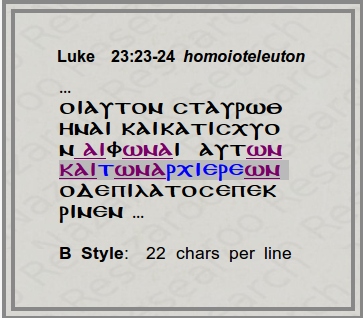
οι δε επεκειντο φωναις
μεγαλαις αιτουμενοι
αυτον σταυρωθη-
ναι και κατισχυον
αι φωναι αυτων
και των αρχιερεων
But they shouted with loud
noises, that He be crucified:
so those voices prevailed,
and those of the chief priests.
INCLUDE LINE: A, D, K, P, W, X, Δ Θ Π ψ, 063 0250 f1, f13, 28 565 700 892 1009 1010 1071 1079 1195 1216 1230 1242 (1253) 1344 1365 1546 1646 2148 2174 Byz, Maj (Majority of all continuous MSS), Lect, ital-c/d/f, Syr-(c/s)/p/h, Copt-Bo(MSS), AEthiop, Arm, Geo, Diatess. etc.
OMIT LINE: P75, א , B, L, 0124 1241, l-241, Ital-a/aur/b/e/ff2, vg, Copt-Sa/Bo(mss)
Here we see plenty of room for the eyes to do a double-take and skip a line while copying, and sure enough, a line was lost by the Alexandrians. There is no point in hunting for theological motives for an insertion when its plainly an accidental omission.
The evidence continues to build that the Alexandrian copyists were less than careful about proof-reading their work, and so when it comes to Haplography omissions, they simply can't be trusted when it comes to the original text.
Westcott/Hort, Nestle, UBS2 all follow Aleph/B, ever hunting for the 'lost ancestor', whatever errors it may contain.
'Modern' versions stupidly adopt the reconstructed Greek, probably following along without thought for the detrimental effect it will have on the purity of the text. Again no footnotes are likely to be found for this clandestine alteration of the traditional text.
Luke 24:42-43
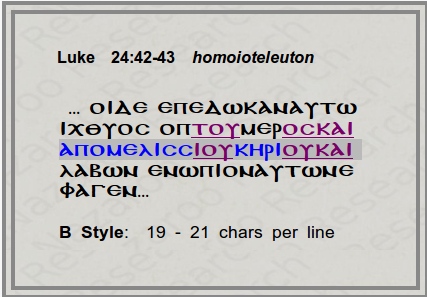
...οι δε επεδωκαν
αυτω ιχθυος οπτου μερος
και απο μελισσιου κηριου
και λαβων ενωπιον αυτων
εφαγεν...
...but they gave Him
also a piece of cooked fish,
and part of a honeycomb:
And He took them and ate...
INCLUDE LINE: K, X, Δ ψ, f1, f13, 28 33 565 700 892 1009 101 1071 1195, 1195-marg, 1230 1241 1242 1253 1344 1365 1546 1646 2148 2174 (1216) Byz, Maj (Majority of all continuous MSS), Lect, l-185m, it-(a)/aur/(b/c)/f/ff2/l/(q)/r1, vg, geo?, Cyril of Jerus. Syr-c/p/h*/pal, Copt-Bo, Arm AEth. geo?, Justin Diatess., Athanasius Augustine Cryil Proclus
OMIT LINE: P75, א A, B, D, L, W, 1079 It-d/e, Syr-s, Cop-Sa/Bo(mss),
Clement Origen Euseb. Athan. Epiph. Cyril
Although yet more 4th/5th cent. Uncials are led astray, it is obvious from the complete lack of any theological content that this is again a mere Haplography error, strongly supported by the line-length, and double-overlap at beginning and mid-line.
"honeycomb" seems superfluous, and so has been consigned to the dustbin by both Alexandrian and Caesarean editors of the 4th century. Yet once again, the editors have no real power over the uncontrolled stream of transmission, and the original text survives intact in the majority of mss. The support of the early fathers for omission is dubious, since it is based on either 'arguments from silence' and/or possible paraphrasing.
Here at least, UBS-2 gives a footnote, but on the authority of WH/Nestle/UBS, 'modern' versions cast aside this interesting bit of text, which may be an allusion to Jonathan's O.T. experience of the honeycomb, and/or perhaps also Samson.